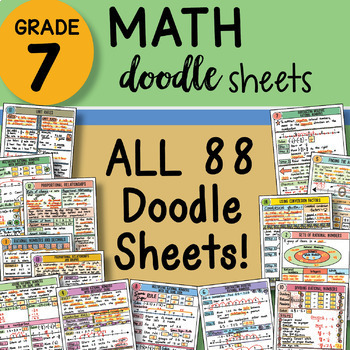7th Grade Math Interactive Notebook DOODLE SHEETS ~ with PowerPoints
- Zip
What educators are saying
Description
7th Grade Math Doodle Sheets ALL YEAR SET
1-88 doodle sheets completed - see preview for all the colorful sheets!
Each doodle sheet + guided practice sheet (88 total) sold separately for $3 each.
All 88 sheets total $264.
SAVE BIG and buy this ALL YEAR SET here for just $59!
THIS PRODUCT includes:
88 Math Doodle Sheets (student blanks and keys)
88 Guided Practice Sheets (student blanks and keys)
88 PowerPoints – to show students the KEY
– two versions of both sheets included: INB and large 8.5 x 11 size
ALL TEKS Aligned– plan for the FULL year included! CC Topics covered too
LIST of 88 Doodle Sheets plus Guided Practice Sheets
# Doodle Sheet Name / TEKS
1 Rational Numbers and Decimals 7.2
2 Sets of Rational Numbers 7.2
3 Adding Rational Numbers with Same Sign 7.3.A
4 Adding Rational Numbers with Different Signs 7.3.A
5 Finding the Additive Inverse 7.3.B
6 Subtracting Positive Rational Numbers 7.3.A
7 Subtracting Negative Rational Numbers 7.3.A
8 Multiplying Rational Numbers with the Same Sign 7.3.A
9 Multiplying Rational Numbers with Different Signs 7.3.A
10 Dividing Rational Numbers 7.3.A
11 Unit Rates 7.4.B/D
12 Proportional Relationships 7.4.A
13 Proportional Relationships and Graphs 7.4.A
14 Using Conversion Factors 7.4.E
15 Converting using Proportions 7.4.E
16 Finding Percent Increase 7.4.D
17 Finding Percent Decrease 7.4.D
18 Using Percent of Change 7.4.D
19 Calculating Markups 7.4.D
20 Calculating Markdowns 7.4.D
21 Finding Total Cost 7.4.D
22 Finding Simple Interest 7.4.D
23 Using Multiple Percents 7.4.D
24 Similar Shapes and Proportions 7.5.A
25 Determining if Two Triangles are Similar 7.5.A
26 Determining if Two 4-Sided Figures are Similar 7.5.A
27 Finding Unknown Measures in Similar Triangles 7.5.A
28 Finding Unknown Measures in 4-Sided Shapes 7.5.A
29 Scale Drawings 7.5.C
30 Finding Area in a Scale Drawing 7.5.C
31 Understanding Circumference 7.5.B
32 Finding Proportionality in Circles 7.5.B
33 Finding Missing Parts of a Circle 7.5.B
34 Experimental Probability 7.6.I
35 Experimental Probability of Simple Events 7.6.E
36 Experimental Probability of Compound Events 7.6.A
37 Making Predictions with Experimental Probability 7.6.C
38 Theoretical Probability 7.6.I
39 Theoretical Probability of Compound Events 7.6.I
40 Finding Probability Using a Table 7.6.I
41 Finding Probability Using a List 7.6.D
42 Finding Probability using a Tree Diagram 7.6.I
43 Making Predictions with Theoretical Probability 7.6.H
44 Conducting a Simulation 7.6.B
45 Linear Relationships 7.7
46 Linear Relationships in Equations 7.7
47 Linear Relationships in Tables 7.7
48 Linear Relationships in Graphs 7.7
49 Writing Two-Step Equations 7.10.A
50 Writing a Verbal Description of a Two-Step Equation 7.10.C
51 Solving Two-Step Equations with the Numberline 7.10.B
52 Solving Two-Step Equations with Models 7.11.A
53 Writing Two-Step Inequalities 7.10.A
54 Writing a Verbal Description of a Two-Step Equation 7.10.C
55 Solving Two-Step Inequalities with Models 7.11.A, 7.10.B
56 Measuring Angles 7.11.C
57 Finding Circumference Using Diameter 7.9.B
58 Finding Circumference Using Radius 7.9.B
59 Area of Circle 7.8.C, 7.9.B
60 Area of Composite Figures 7.9.C
61 Using Area to Solve Problems 7.9.C
62 Volume of Rectangular Prisms 7.9.A
63 Volume of Rectangular Pyramids 7.8.A
64 Volume of Triangular Prisms 7.9.A
65 Volume of Triangular Pyramids 7.8.B
66 Lateral and Surface Area of a Prism 7.9.A
67 Lateral and Surface Area of a Pyramid 7.9.D
68 Solving Problems in Dot Plots 7.6.G
69 Comparing Dot Plots 7.12.A
70 Solving Problems in Box Plots 7.12.A
71 Comparing Box Plots 7.12.A
72 Solving Problems in Circle Graphs 7.6.G
73 Population and Samples 7.6.F
74 Using Dot Plots to Make Inferences 7.12.B
75 Using Dot Plots to Compare Populations 7.12.C
76 Using Box Plots to Compare Populations 7.12.B, 7.12.C
77 Using Statistical Measures to Compare Populations 7.12.B, 7.12.C
78 Calculating Sales Tax 7.13.A
79 Calculating Withholding 7.13.A
80 Calculating Income Tax 7.13.A
81 Calculating Compound Interest 7.13.E
82 Calculating Simple Interest 7.13.E
83 Comparing Compound and Simple Interest 7.13.E
84 Purchasing Decisions 7.13.F
85 Personal Budgets 7.13.B
86 Family Budgets 7.13.B
87 Family Budgets in Different Cities 7.13.D
88 Net Worth Statements 7.13.C


